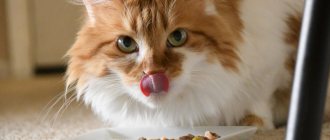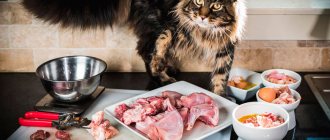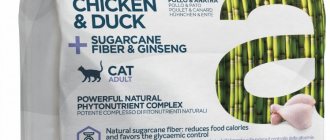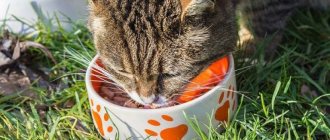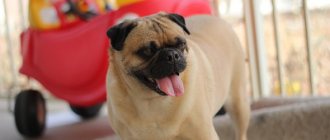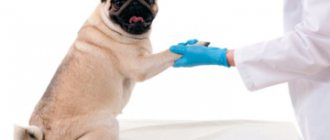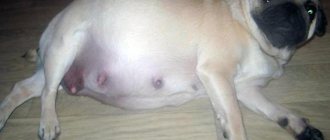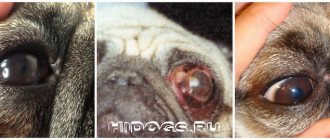Pugs are an ancient breed of decorative dogs that have gained immense popularity around the world. The basis of high-quality pet care is the preparation of a diet that will avoid most health problems and extend the pet’s life to the maximum possible. Despite its activity, the breed is prone to obesity. In this article, we will figure out what type of food is best to choose for a pug, what feeding regimen is needed for a puppy and an adult dog, and we will find out what to do if a negative reaction to food occurs.
Feeding dry food
Industrial feeds are offered by manufacturers in a huge range. The main problem for the owner will be choosing the one that will satisfy the needs of the pet.
Using ready-made food makes life much easier, since the manufacturer indicates recommended feeding portions.
Pugs' stomachs handle solid foods best, so feeding them dry kibble is a great option. Please note that this breed should not use a mixed type of food: ready-made food in the morning, natural food in the evening. Such experiments will lead to gastrointestinal upset of the animal.
In addition to dry food, wet canned ready-made food can be introduced into the diet. This product can be used as independent feeding or added to natural food. For example, mix with cereals.
Soaking dry granules is allowed, but you should not do this with boiling water, because most of the vitamins and microelements will be destroyed. You can do this with milk or kefir, but you should not leave such a portion of food for re-feeding. You'll have to throw away anything your pug doesn't finish eating.
Photo: pixabay.com
Feed comparison
There are several types of feed that are considered “pedigree” and are recommended for use. The specific type is selected taking into account the dog’s preferences, veterinarian advice and the animal’s diseases.
Royal Canin
In the line of this brand there is a specialized food designated “pug”. Translated from English, the word means pug, flat nose. The granules are made in the shape of a trefoil, which makes them easy to grasp for those with a flat muzzle. The composition of Royal Canin is balanced and rich.
Photo: amazon.com
Canidae
Holistic from the USA, which includes everything you need for a pug pet. There is meat, meat flour, vegetables, probiotics, medicinal herbs.
Photo: amazon.com
Acana
Belongs to the holistic class, which is most preferable for pug nutrition. It contains about 60% natural meat, a complex of minerals, fruits, vegetables, and medicinal herbs, which have a positive effect on the functioning of the gastrointestinal tract. There are no flavorings or by-products that can cause allergies.
Photo: amazon.com
FirstMate
Belongs to the super premium class, produced in Canada and Australia. It has a very diverse composition, not inferior in quality to natural: three types of meat, vegetables, minerals, vitamins. Interestingly, the meat included in the composition belongs to the Human Grade category, that is, it can be consumed by humans.
Photo: amazon.com
If possible, the owner should choose holistic foods that eliminate as much as possible the body’s negative reactions to nutrition. A noticeable disadvantage of this choice is the high cost, which, however, cannot be compared with the cost of treating the consequences of using low-quality feed.
We also performed a detailed analysis of the following feeds: Proplan, Monje, Dog Chow, Brit.
When to change food
Any owner always closely monitors the condition of his pet. There are several reasons why you should change food:
- The pug simply refuses to eat it;
- The first signs of weight gain are noticeable;
- The dog is not gaining weight well and is not active. Choose a higher-calorie type of food without increasing portions;
- Signs of an allergic reaction appeared: scabies, dull fur, sores.
Natural diet
When choosing natural food for a pug, the owner faces a number of difficulties, since he will have to independently create a balanced menu, calculate the serving size and provide additional nutrition to the animal with vitamin complexes.
Often suffering from obesity and allergies, Pugs will eat anything in sight. It is difficult for the owners to refuse a baby who looks pitifully at them with his beady eyes. Here is an example of such behavior!
Feeding your pug regular food is strictly prohibited.
The diet must include:
- Meat and meat products – at least half of the daily portion. It could be beef, rabbit or turkey;
- Cereals make up almost a quarter of the diet. Usually they use rice, buckwheat or oatmeal, focusing on the pet’s taste;
- Dairy products. About 20% should be fermented milk products. Interestingly, it is recommended that pugs be given low-fat milk in their diet. It helps cope with heartburn, which often torments dogs;
- Fish – boiled or raw, but strictly without bones;
- Fruits and vegetables. Vegetables are given stewed, fruits are given raw.
Meat and dairy products should not be given at the same feeding. This will lead to gastrointestinal upset.
Dogs do not need a varied diet, the main principle is balance. During the week, the owner should change cereals, leaving about 60% meat in the diet and adding various vegetables.
How many times a day is best?
Just as with dry food, in relation to pugs, fractional feeding is most useful. At least 3 times a day.
- The morning diet , as a rule, consists of cottage cheese and fermented milk products.
- At lunch, the pug should receive 50% of the total daily portion. Meat raw or lightly scalded. Additionally, chopped vegetables and a quail egg are given twice a week. Bones only when raw.
- Dinner. By-products require heat treatment. It is better to postpone them for the evening. No more than 20% of the diet should be cereal.
Between main feedings, small snacks with low-calorie foods are allowed. You can give apples and other fruits between breakfast and lunch, and meat tails or chewing bones before dinner.
What to feed a pug puppy
It's no secret that a baby's diet and menu are different from those of an adult dog. Let's figure out what to feed a little pug.
Keep the type of food that the baby received in the nursery. Transfer to another type should be done only after three weeks.
From 1 month
The puppy begins to develop very actively, so it needs more satisfying and nutritious food. During this period, you can already give him low-fat kefir, cottage cheese, and boiled vegetables. If ready-made food is used, the puppy is given soft, wet kibbles intended for babies his age.
Puppies are fed 6 times a day. The serving size is calculated based on the weight of the pet. It is believed that the daily requirement is 5-7% of the dog’s weight. If the puppy weighs 2 kg, the consumption rate will be 140 g. This figure is divided by the number of feedings per day, resulting in a portion size per feeding.
This is how the baby receives complementary foods for the first time, look!
From 1 to 6 months
As the pug gets older, the number of feedings per day decreases to three, and with them the serving size. By six months, the serving size is calculated using the formula: 4% of the animal’s weight.
From 6 months to a year
The dog's diet includes all the products that an adult dog needs. By this time, the dog is transferred to two meals a day.
Compliance with the diet is especially important for the breed. If the dog refuses food, it should be put in a cool place. There is no need to increase the portion at the next feeding.
How to feed a pug puppy
From 1.5 months, the baby can be on a full diet. He is fed 6 times a day in small portions. The first rule of feeding a baby is balance, the second is usefulness, and the third is regularity.
Puppies need proper nutrition
What foods should be in the diet
Puppies can be given the same food as adult dogs. Raw meat - beef, chicken, turkey and other lean types. Be sure to add fats and grains.
Diet regimen (frequency of feedings and volume of daily portion):
- up to 2 months - 6 times a day, 100 g;
- 2-4 months - 4 times a day, 120 g;
- 4-6 months - 3 times a day, 140 g;
- from 6 months - 2 times a day, approximately 150 g.
The portion is adjusted according to weight; for puppies it can be increased slightly, up to 5-6% of weight.
What to feed an adult pug
Ready-made food should be premium class or higher; preference is given to holistic food.
We must not forget that the dog must be provided with access to clean water, which must be changed twice a day.
Natural food should be warm. The meat is cut into small pieces, convenient for consumption. Vegetables and fruits are given both raw and stewed. Many pugs refuse to eat them, so training for such foods begins very early. For example, Tasha doesn’t really agree, but she chews the zucchini and carrots very carefully!
It is advisable to choose the type of food once and for all, since transitions from one type to another can have a detrimental effect on the animal’s digestion.
An adult dog is fed twice a day. For example, at 7 am and at 22 pm. It is acceptable to give an afternoon snack, but you should not get carried away with all sorts of goodies.
Feeding frequency for puppies
From 1 to 3 months
At the age of 1 month, the puppy is taken away from its mother and fed after a walk and sleep. It is recommended to immediately teach your pug to eat from a bowl and not from your hand.
First, the diet consists of fermented milk products: cottage cheese, kefir, fermented baked milk.
Expert opinion
Anna Abramenko
An avid dog lover. Experience in veterinary medicine since 2009.
Ask a Question
When feeding natural food, it is not recommended to replace or mix in dry granules.
The daily norm is distributed evenly into 5-6 servings. At 2 months, maintain an interval of 3-3.5 hours between feeding the pug.
From 3 to 7
During this period, the puppy is transferred to four meals a day. By seven months, the pug reaches the size of an adult dog.
It is necessary to ensure that the dog’s diet is varied.
If the products offered to the puppy before are suitable for him: they do not cause allergies, then a menu that is approximate in composition remains. The number of feedings is reduced to 3-4, but the portions are increased.
After 7 months
The puppy is given two or three meals a day. The dog is growing and developing, but not as actively as before. In case of a sharp increase or decrease in weight, nutritional adjustments are recommended. Precisely selected food for a pug puppy is a guarantee of its health and vigor.
For an adult dog
An adult is fed 2 times a day.
The pug is switched to this diet from the first year. An individual diet for an adult dog is developed based on physical activity and the presence of diseases.
For a nursing bitch
When a female feeds her babies, her need for vitamins and minerals increases. The dog especially needs calcium and protein. If the diet is poor, the puppies will not be able to grow fully.
Food should not be so high in calories, but varied and balanced.
During lactation, it is important that the bitch receives all the nutrients in the right quantities.
How to feed an old dog
With age, the activity of pugs fades away, which is a signal to revise the menu. In addition, diseases that occur with age are also taken into account.
An older dog's food should be less high in calories and contain less fat and protein. Older representatives of the breed are prone to constipation, so it is necessary to provide the body with fiber. For example, wheat bran.
If the need to review the diet is dictated by age-related diseases, you should consult a veterinarian.
Feeding pregnant and lactating bitches
The diet of a pregnant bitch is not very different from usual. It should be additionally enriched with vitamins and calcium. Use special feed or natural food supplements.
During this period, the bitch’s taste preferences change; she may beg for inappropriate foods. This indicates a lack of vitamins.
After childbirth (the first 10 days) there is no need to give meat products to exclude eclampsia. During this period, the bitch is supported with vitamin supplements and dairy products.
Puppy feeding schedule
The basics of feeding a puppy and an adult animal are slightly different. During the period of rapid development and tooth growth, animals need much more minerals and vitamins.
The main difference between the diet of a puppy 1 to 4 months old and the diet of an adult animal is the number of feedings. If the second needs 1-2 times a day, then the first needs 4 or 5. The puppy is actively growing, so he needs a lot of food.
In the morning, the pet is fed dairy products - cottage cheese, milk, kefir, yogurt. A small amount of porridge (buckwheat, rice) with vegetable oil. You can sweeten your food a little with honey. Or dilute well-cooked cereal with egg yolk, preferably quail.
The second feeding is stewed vegetables, fruits, dried fruits. You can offer the puppy a slice of black bread with butter and cheese, or a piece of salted herring. It is useful to feed your dog a clove of crushed garlic several times a week.
For lunch and dinner, they serve meat that has been previously cleaned of bones, veins and fat. It must be raw. Puppies are often given bones. First, they are thoroughly crushed, beaten and soaked in milk.
For dogs aged 4 to 7, three meals are enough. The basis of the diet is still raw meat and dairy products. It’s just that during this period their number gradually increases. In the morning they also give cottage cheese, kefir and porridge. Meat during the day and evening.
A pet aged 7 to 12 months is fed like an adult dog - 2 times a day. For breakfast they give you everything except meat or fish. For dinner or lunch - meat products and bones. After a year, the animal is accustomed to the diet of an adult dog.
How to avoid obesity
Pugs are ready to eat everything that seems tasty to them. This eating behavior often leads to obesity, which leads to heart problems and early aging of the pet. To avoid obesity follow the rules:
- Do not offer additional snacks to your pet;
- Limit treats;
- Carry out periodic weighing;
- If the weight creeps up, contact your veterinarian for a diet prescription.
Photo: wikimedia.org
Treatment of diseases with food
In the presence of various types of diseases, it becomes necessary to transfer the pet to specialized food, either completely or partially. Please note that in this case you will have to give up natural food and switch to ready-made medicinal food.
Naturally, not just any disease can be cured with dry food, but for example: obesity, allergies, molting, indigestion. Almost all premium food lines have products that can be used for these problems. It is better to choose specialized food of the brand that the dog is currently eating.
Menu for pregnant and lactating women
During pregnancy, increased stress is placed on the bitch’s body; not only her health, but also that of future puppies, depends on nutrition during this period. Veterinarians and breeders agree that you should not overfeed your dog during this period. It is better to exclude cereals from your diet and replace them with fresh vegetables.
Often, due to toxicosis, the dog refuses to eat. In case of pregnancy, fasting is unacceptable, so it makes sense to offer the expectant mother a piece that is more appetizing to her. The number of feedings increases from 3 to 6 times a day, but it is better to give small portions themselves.
During this period, you should avoid fatty meats and raw fish. But if a dog wants to try a previously forbidden citrus fruit, it’s quite possible to pamper it with a small amount. The main principle of this period is more vegetables, less carbohydrates and only easily digestible white meat.

